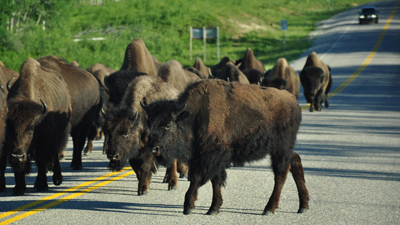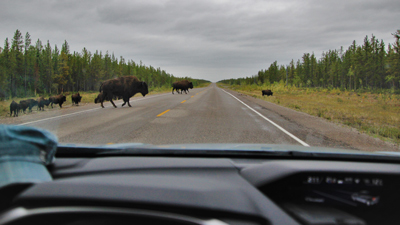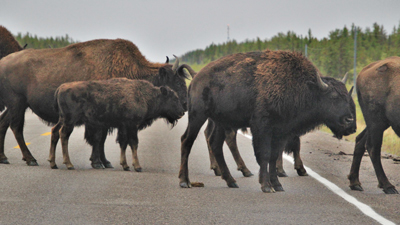
Bison on roads
Wood Buffalo National Park
Seeing bison on the roads is one of Wood Buffalo National Park’s most iconic experiences. That first road trip down Highway 5, where distant brown objects crowd the road and welcome you to Canada’s north, is like no other welcome you’ve seen before.
Bison are found throughout the park and can be encountered anywhere. Even though they look docile, bison are unpredictable wild animals, and may charge without warning. Keeping wildlife wild is a shared responsibility. It’s important to remember that your safety and the safety of the bison is in your hands.
Bison on Highways:
NWT Highway 5 is a fully paved highway with a 90kph speed limit. At relatively high speeds, collisions with bison can be dangerous and even fatal. Most bison strikes in Wood Buffalo occur at night and during the change of seasons, when the north’s epic “midnight sun” disappears and drivers are slow to adjust their driving habits. Highway 5 is the wrong highway to drive in a rush. Bison and other wildlife, including moose and black bears are common and can be encountered anywhere.
Bison on Secondary Roads:
Pine Lake Road and many of the park’s secondary roads travel deep into bison habitat. You can expect to see bison on the way to Pine Lake, the Salt Plains Day-Use Area and Peace Point, Alberta. Obeying posted speed limits and driving with care and alertness is the best way to ensure your safety.

What is it with bison and roads?
Wood Buffalo National Park is home to around 3500 bison, and is full of excellent grazing and foraging habitat year round. In open and less forested places, grasses and willows grow more abundantly, which in turn, provides good forage for bison. Highways and roads built through the park act like long, narrow strips of excellent grazing habitat. They provide bison with good places to graze and easy travel corridors. At times, entire herds can be seen using park roads and adjacent areas for feeding, calving and wallowing.
Wildlife Watching and Roadside Bison

Wildlife watching is one of the main reasons for visiting Wood Buffalo National Park. Whether you’re from far away or a long time local—viewing bison never gets old. Remember that bison and other motorists are counting on you to do this safely and responsibly.
What to do when you see a herd of bison:
When encountering bison on the roadway, whether it’s one individual or fifty- pack your patience. Simply stop the car when bison are present and wait. Slowly proceed at idle speed. Bison will slowly, but surely, part and give you a window to safely drive past. Never honk your horn, shout or charge bison with your vehicle. Use your 4-way flashers and help alert other motorists that bison are present.
When viewing bison from a vehicle, remember to:
- Stay in your vehicle and never approach bison. Take your photos from a safe distance. It is illegal to approach, harass or entice bison for any reason.
- When viewing bison along the highway, pull over on the shoulder and use your signals and 4-way flashers to indicate what you’re doing to other motorists.
- If it’s winter, make your viewing brief and safe. If poor weather conditions are present and visibility is poor, consider not stopping and try again later or another day. (A bison-less visit to the park is extremely rare!).
What to do when you see a herd of bison:

When encountering bison on the roadway, whether it’s one individual or fifty- pack your patience. Simply stop the car when bison are present and wait. Bison will slowly, but surely, part and give you a window to safely drive past. Never honk your horn, shout or charge bison with your vehicle. Use your 4-way flashers and help alert other motorists that bison are present.
If you are on foot:
- Be aware of your surroundings and watch for wildlife, especially if you are on a trail where you might not be able to see around the next corner
- Startled bison often run away, then stop and look back. Detour around any bison that remain in the area. Wait for bison to move, walk around the bison leaving them space to escape, or back away slowly.
- Do not hike with ear buds. Pay attention to your surroundings.
- Keep your dogs on leash.
- Do not approach a bison closer than 100m and never try to chase or scare bison away
Rule of thumb – what does 100m look like?

Hold your fist straight out in front of you and raise your thumb. Cover the bison (who is standing sideways) with your thumb. If the bison is totally covered you are about 100m away, a safe distance. If your thumb does not cover the bison, retreat slowly.
Bison warning signs
Animals have many warning signs: dogs growl, cats hiss, bears huff. Bison have various warning signs to watch out for.
Be alert and aware of bison warning signs and retreat slowly when a bison:
- Snorts, shakes, or tosses its head
- Raises its tail
- Turns its back, raises its tail and defecates
- Paws the ground
- False charges
- If bison stop grazing to stare, back away immediately until the animal returns to grazing
Bison rut
The bison rut, or mating season, begins late July and carries through until early SeptemberDuring the rutting season, bison bulls are more aggressive and less cautious of vehicles and people. Motorists and hikers alike should be extremely cautious at all times, but especially during the rut.
Protecting Bison-a Species at Risk
Wood bison are one of the reasons for the park’s designation as a world heritage site and the park is home to almost two thirds of all the free-roaming bison found in Canada. Parks Canada carefully monitors Bison populations and studies them as a key indicator of the park’s ecological integrity through bison counts, aerial surveys, using tracking collars and more.
Protecting them is a joint responsibility for Parks Canada, visitors and residents alike. If you see:
- Injured or dead bison
- Hunting for bison (protected as a species at risk)
- Anyone harassing or endangering wildlife
Please inform the Wood Buffalo National Park Duty Officer at: 1-867-872-0404.
Help us protect visitors, travelers and the wildlife that make the park their home. Drive safely as you enjoy the beauty of Wood Buffalo National Park.
- Date modified :
